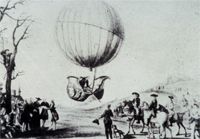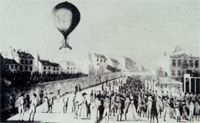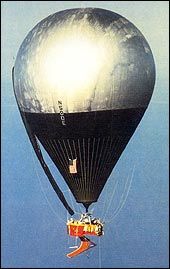About Balloon History
On the 19th September 1783 French scientist Pilatre De Rozier launched the 'Aerostat Reveillon', the worlds first hot air balloon. No humans were sent on this maiden flight, intead were a sheep, a duck and a rooster. The balloon stayed in the air for a grand total of 15 minutes before crashing
The first manned 'flight' came a few months later, on the 21st November. Two French brothers, Joseph and Etienne Montgolfier launched the balloon from Paris and flew for 20 minutes. Hot air ballooning was born.
Only a few days later on 1st December 1783, Professor Jacques Charles made the first gas balloon flight from Paris. This stayed aloft for 2 hours and travelled and heights of up to 2,000 feet before landing 27 miles away in the small town of Nesle.
Charles became the first person to see "two sunsets in one day" having made a first landing to let out his co pilot Aine Roberts.
Balloon flights became an attraction and brave "aeronauts" sought sponsors to finance the building of the balloon with the promise of considerable return from spectator tickets sold to view the launch. An Italian called Lunardi made one of the first flights from London, landing close to the South Mimms services where a plaque commemorates this event.
In 1785 the English Channel was considered the first step to long distance ballooning.
French balloonist, Jean Pierre Blanchard, and his American co pilot John Jefferies were the first to make the crossing in a balloon. This was a giant leap forward the ballooning pioneers, and also a notable benchmark in ballooning history.
This same year Pilatre de Rozier was tragically killed in his attempt at crossing the channel. Unfortunately, his hot air balloon exploded half an hour after takeoff due to the experimental design of using a hydrogen balloon and hot air balloon tied together.
Now a jump ahead in time 100 years: In August of 1932 Swiss scientist named Auguste Piccard was the first to achieve a manned flight to the Stratosphere. He reached a height of 52,498 feet, setting a new altitude record. In the next couple of years, altitude records continued to be set and broken every couple of months - the race was on to see who get reach the highest point in a hot air balloon.
In 1935 a new altitude record was set, which was to not be broken for 20 years. The balloon Explorer 2, a gas helium model reached an altitude of 72,395 feet (thats 13.7 miles!) For the first time in history, it was proven that people could survive in a pressurized chambers at extremely high altitudes. This flight set a milestone for aviation and even helped pave the way for future space travel.
The Altitude record was broken again in 1960 when Captain Joe Kittinger made a parachute jump from a balloon that was at a height of 102,000 feet (19 Miles!). The balloon broke the existing altitude record and Captain Kittinger, the high altitude parachute jump record. He even broke the sound barrier with his body!
The Atlantic Challenge
In 1978, the Double Eagle II was the first balloon to cross the Atlantic, another major event in the History of Ballooning. After many unsuccessful attempts this mighty Ocean had finally been crossed. It was a helium filled model,and it carried 3 passengers, Ben Abruzzo, Maxie Anderson and Larry Newman. They set a new flight duration time at 137 hours.
The Pacific Challenge
The first Pacific crossing was achieved just 3 years later in 1981. The Double Eagle V launched from Japan on November 10th and landed 84 hours later in Mendocino National Forest, California. The 4 pilots set a new distance record at 5,678 miles. 3 years after this, Captain Joe Kittinger flew 3,535 miles on the first solo transatlantic balloon flight, setting yet another record.
In 1987 Sir Richard Branson and Per Lindstrand were the first to cross the Atlantic in a hot air balloon, rather than a helium/gas filled balloon. They flew a distance of 2,900 miles in a record breaking time of 33 hours. At the time, the envelope they used was the largest ever flown, at 2.3 million cubic feet of capacity. A year later, Per Lindstand set yet another record, this time for highest solo flight ever recorded in a hot air balloon - 65,000 feet!
The great team of Richard Branson and Per Lindstrand paired up again in 1991 and became the first to cross the Pacific in a hot air balloon. They travelled 6,700 miles in 47 hours, from Japan to Canada breaking the world distance record, travelling at speeds of up to 245 mph. 4 years later, Steve Fossett became the first to complete the Transpacific balloon route by himself, travelling from Korea and landing in Canada 4 days later.
Finally, in 1999 the first around the world flight was completed by Bertrand Piccard and Brian Jones. Leaving from Switzerland and landing in Africa, they smashed all previous distance records, flying for 19 days, 21 hours and 55 minutes.
It's interesting to see how the development of the the hot air balloon has gone full circle on itself. At the very start, the first balloonists burnt materials onboard the balloon to generate heat to propel the envelope into the air. This theory then became obsolete as hydrogen and laterly helium designs were introduced as it was considered safer and more reliable than flying with an open flame. It is only within the last 50 or so years that hot air balloons have come back into interest.
Ballooning History in Hampshire - Click Here!










